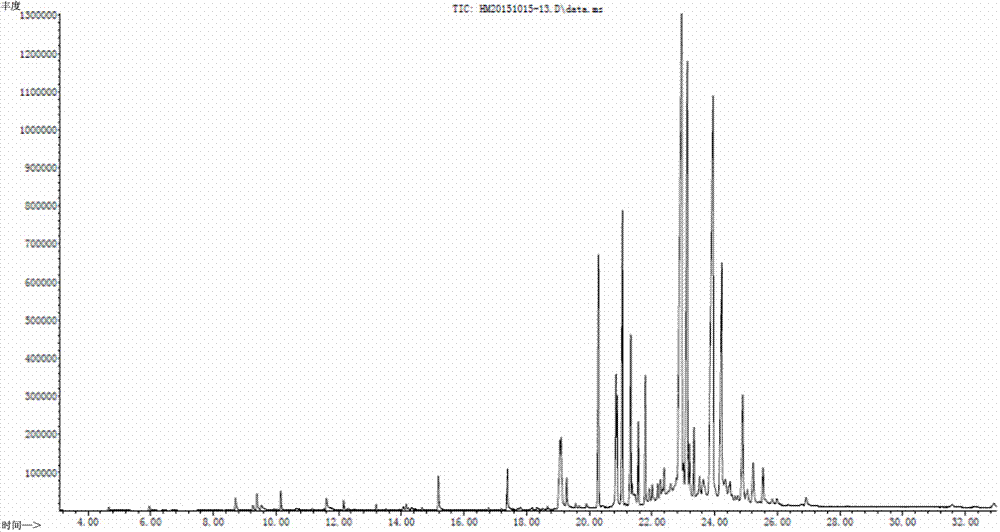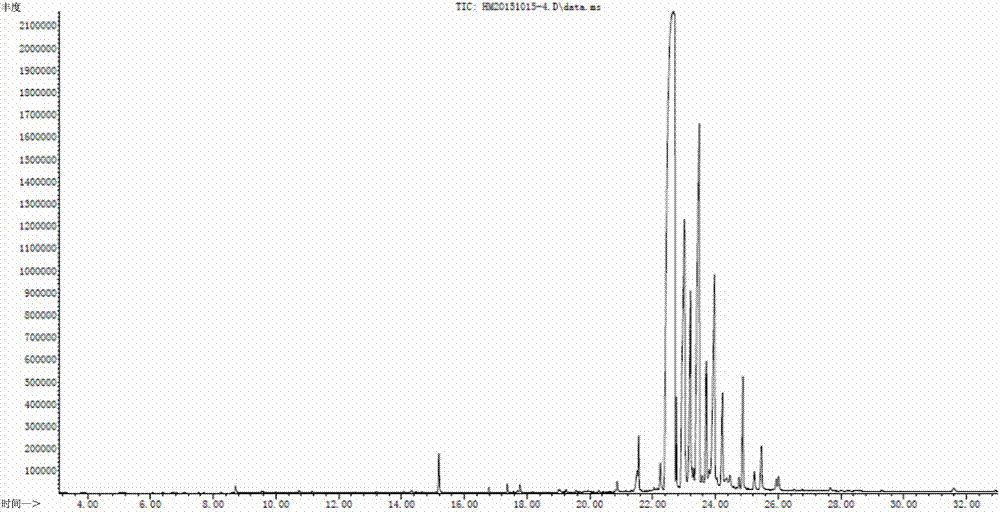A method for identifying the species of Dalbergia bali with minimal damage based on fingerprints
A fingerprint and species technology, applied in the field of wood identification, can solve the problems of complicated process, large sampling amount, far difference in function and value, etc., and achieve the effect of easy repair and accurate identification results.
- Summary
- Abstract
- Description
- Claims
- Application Information
AI Technical Summary
Problems solved by technology
Method used
Image
Examples
Embodiment 1
[0053] Embodiment 1: 1. Follow the steps (1.1) (1.2) in the pretreatment method of the above-mentioned standard sample to obtain the GC-MS 3D fingerprint of sample 1 (such as figure 2 ), and the matching table of the chemical substance information of the characteristic peaks of the spectrum and Table 1, as shown in Table 2 below.
[0054] Table 2
[0055]
[0056] 2. Identification
[0057] According to the chemical substance information table (Table 2) and Table 1 and figure 1 and figure 2 From the comparison, it can be seen that: ① The consistency of the retention time (D1) requires an allowable deviation of ±0.5min, which meets the requirements. ② The consistency of the mass spectrum (D2) is that the search matching rate is greater than 90%, among which there are ten characteristic peaks whose mass spectrum matching rate is less than 90%, and the mass spectrum matching rate of thirteen characteristic peaks are greater than 90%, which do not meet the requirements. ...
Embodiment 2
[0058] Embodiment 2: 1. Follow the steps (1.1) (1.2) in the pretreatment method of the above-mentioned standard sample to obtain the GC-MS 3D fingerprint of sample 2 (such as image 3 shown), and the matching table of the chemical substance information of the characteristic peaks of the spectrum compared with Table 1, as shown in Table 3 below.
[0059] table 3
[0060]
[0061] 2 identification
[0062] According to the chemical substance information table (Table 3) and Table 1 and figure 1 and image 3 From the comparison, it can be seen that: ① The consistency of the retention time (D1) requires an allowable deviation of ±0.5min, which meets the requirements. ② The consistency of the mass spectrum (D2) is that the search matching rate is greater than 90%, among which the mass spectrum matching rate of one characteristic peak is less than 90%, and the mass spectrum matching rate of 22 characteristic peaks is greater than 90%, which meets the requirements. ③ The accur...
Embodiment 3
[0063] Example 3: 1. Follow the steps (1.1) (1.2) in the pretreatment method of the above-mentioned standard sample for the test sample 3 to obtain the GC-MS 3D fingerprint of the sample 3 (such as Figure 4 ), and the matching table of the chemical substance information of the characteristic peaks of the spectrum and Table 1, as shown in Table 4 below.
[0064] Table 4
[0065]
[0066] 2. Identification
[0067] According to the chemical substance information table (Table 4) and Table 1 and figure 1 and Figure 4 The comparison shows that: ① The consistency of the retention time (D1) requires a tolerance of ±0.5min, and the retention time deviation of the characteristic peak 6 (4-methoxy-1,2-benzenediol) is greater than 0.5min, which is listed as a suspicious characteristic peak . ② The consistency of the mass spectrum (D2) is that the search matching rate is greater than 90%, among which the matching rate of mass spectrum of seventeen characteristic peaks is less th...
PUM
 Login to View More
Login to View More Abstract
Description
Claims
Application Information
 Login to View More
Login to View More - R&D
- Intellectual Property
- Life Sciences
- Materials
- Tech Scout
- Unparalleled Data Quality
- Higher Quality Content
- 60% Fewer Hallucinations
Browse by: Latest US Patents, China's latest patents, Technical Efficacy Thesaurus, Application Domain, Technology Topic, Popular Technical Reports.
© 2025 PatSnap. All rights reserved.Legal|Privacy policy|Modern Slavery Act Transparency Statement|Sitemap|About US| Contact US: help@patsnap.com



